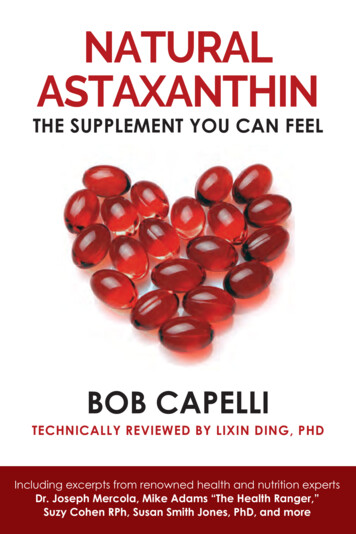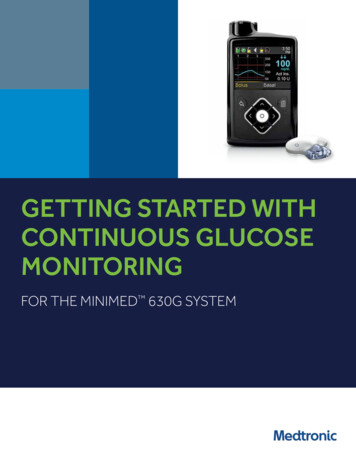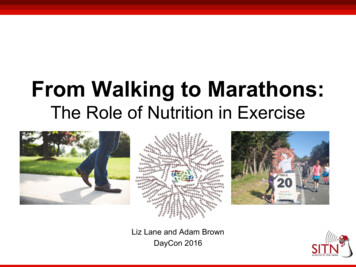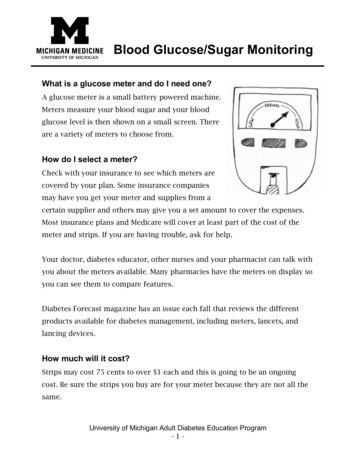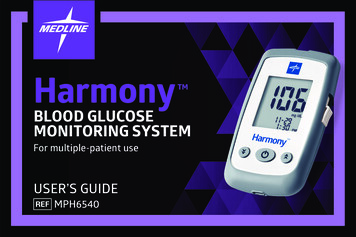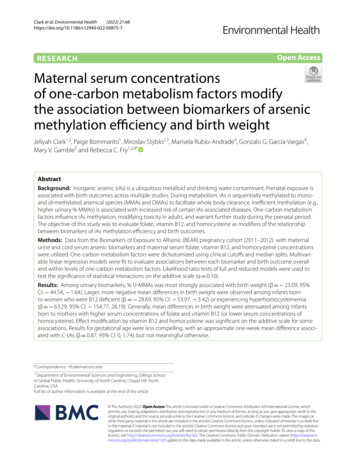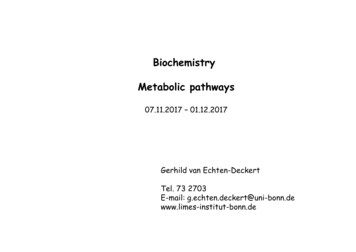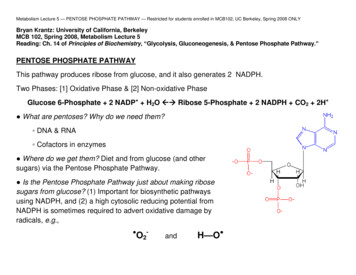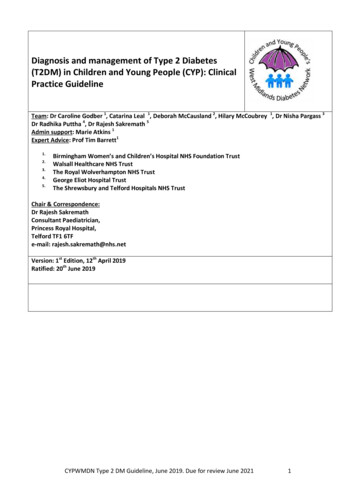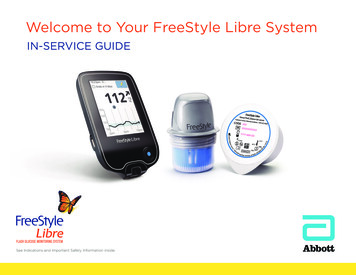
Transcription
Asia Pac J Clin Nutr 2018;27(2):341-346341Original ArticleAstaxanthin improves glucose metabolism and reducesblood pressure in patients with type 2 diabetes mellitusNafiseh Sokri Mashhadi PhD1, Mehrnoosh Zakerkish MD2, Javad Mohammadiasl PhD3,Mehdi Zarei PhD4, Majid Mohammadshahi PhD5, Mohammad Hossein Haghighizadeh6MSc1Nutrition and Metabolic Diseases Research Center and Department of Nutrition, Ahvaz JundishapurUniversity of Medical Sciences, Ahvaz, Iran2Department of Endocrinology and Metabolism, Health Research Institute, Diabetes Research Center,Jundishapur University of Medical Sciences, Ahvaz, Iran3Deptment of Medical Genetics, Faculty of Medicine, Ahvaz Jundishapur University of Medical Sciences,Ahvaz, Iran4Department of Food Hygiene, School of Veterinary Medicine, ShahidChamran University, Ahvaz, Iran5Department of Nutrition, Hyperlipidemia Research Center, Ahvaz Jundishapur University of MedicalSciences, Ahvaz, Iran6Department of Biostatistics and Epidemiology, Faculty of Public Health, Ahvaz Jundishapur University ofMedical Sciences, Ahvaz, IranBackground and Objectives: This randomized, placebo-controlled trial was performed for 8 weeks to investigate the potential effects of astaxanthin (AST) supplementation on the adiponectin concentration, lipid peroxidation, glycemic control, insulin sensitivity, and anthropometric indices in participants with type 2 diabetes mellitus.Methods and Study Design: We enrolled 44 participants with type 2 diabetes who met our inclusion criteria.Eight milligrams of AST supplementation or a placebo were randomly administered once daily for 8 weeks tothese participants. Results: The 8-week administration of AST supplementation increased the serum adiponectinconcentration and reduced visceral body fat mass (p 0.01), serum triglyceride and very-low-density lipoproteincholesterol concentrations, and systolic blood pressure (p 0.05). Furthermore, AST significantly reduced thefructosamine concentration (p 0.05) and marginally reduced the plasma glucose concentration (p 0.057). Conclusions: We demonstrated that because participants with type 2 diabetes often have hypertriglycemia and uncontrolled glucose metabolism; our findings of dual beneficial effects are clinically valuable. Our results may providea novel complementary treatment with potential impacts on diabetic complications without adverse effects.Key Words: astaxanthin, dyslipidemia, hypertriglycemia, adiponectin, diabetes mellitusINTRODUCTIONType 2 diabetes mellitus is caused by an imbalance between insulin supply and demand, which is indicated byglucose and lipid abnormalities.1 The etiology of the development of insulin resistance is complex and not fullyunderstood.2 However, many studies have indicated thatderegulation of adipocytokines such as adiponectin, secreted from the adipose tissue, affects insulin sensitivityinvolved in glucose and lipid metabolism.3 The clinicalmanagement of diabetes focuses on the control of hyperglycemia and insulin resistance by using a combination ofnutritional and pharmacological therapies to control noninsulin-dependent diabetes mellitus because of increasedsignificant microvascular and macrovascular complications.4 Therefore, several natural products such as antioxidants are extensively used to arrest the progression ofdiabetic complications or potentially prevent or delay thedevelopment of diabetic disorders.5Astaxanthin (AST) is a natural carotenoid compoundpresent in various microorganisms and seafoods.6 A majordietary source of AST is Haematococcuspluvialis, a greenmicroalga that has a high AST content, and is eaten asfood by fish and marine organisms.Studies have reported that AST can perform variousbiological activities. The effects of AST on lipid metabolism and antioxidant defense mechanisms are severaltimes higher than those of alpha-tocopherol and vitaminC.7,8 Moreover, AST has positive effects on cholesteroland lipid metabolism, as well as on the immune responseCorresponding Author: Dr Majid Mohammadshahi, Department of Nutrition, Hyperlipidemia Research Center, AhvazJundishapur University of Medical Sciences, Ahvaz, Iran.Tel: 98-611-3339092; Fax: 98-611-3335200.Email: shokri.n@ajums.ac.ir; shahi334@gmail.comManuscript received 26 June 2016. Initial review completed 28September 2016. Revision accepted 16 November 2016.doi: 10.6133/apjcn.052017.11
342NS Mashhadi, M Zakerkish, J Mohammadiasl, M Zarei, M Mohammadshahi and MH Haghighizadehthat occurs through antioxidant defense mechanisms inhealthy humans or participants with cardiovascular diseases who have enhanced antioxidant properties.9,10Clinical trials have evaluated AST as a scavenger offree radicals and protective agents, especially in cardiovascular diseases. To the best of our knowledge, no human studies have evaluated the effects of the dietary intake of AST on the lipid profile and blood sugar, particularly in high-risk participants with type 2 diabetes mellitus who have enhanced oxidative stress and inflammation.Thus, we conducted a trial for 8 weeks to assess the potential effects of 8 mg of the AST supplement on lipidperoxidation, glycemic control, serum adiponectin concentration, anthropometric indices, and blood pressure inparticipants with type 2 diabetes mellitus receiving oralantidiabetic drugs to control hyperglycemia.PARTICIPANTS AND METHODSStudy populationThis study was a single-center, double-blind (participantsand study staff), randomized (1:1 allocation), parallel,placebo-controlled trial. Forty four volunteers with type 2diabetes were referred to the Diabetes Research Center atthe Ahvaz University of Medical Sciences. The patientswho met our inclusion criteria were then enrolled afterwritten consent was obtained. The inclusion criteria wereas follows: age of 30–60 years; definitive diagnosis oftype 2 diabetes with no insulin therapy; no pregnancy orlactation; absence of self-reported specific diseases andmalignancies, kidney failure, heart disease, thyroid, andother inflammatory diseases; not taking vitamin and antioxidant supplements during the last 6 months; and nosmoking or drinking.Moreover, participants were excluded if they were taking antioxidant supplements, unable to follow the study,or participating in another clinical drug study within 30days before entry in the present study. An equal numberof participants were randomly allocated into one of twogroups: the AST treatment or identical placebo group. Allprocedures were performed under the supervision of anutritionist at each step, during which the participantswere advised to eat a specific diet, perform physical activity, and take antidiabetic drugs. The protocol of thisrandomized clinical trial was approved by the ResearchEthics Committee of Ahvaz University of Medical Sciences and was registered with the Iranian Registry ofClinical Trials (IRCT2015081623645N1).MethodsTrained researchers performed all the data collection andmeasurements. Several demographic characteristics werecollected by the interviewers, including age, sex, diabetesduration, medical history, education status, economicstatus, and type of antidiabetic or antihypertensive drugsreceived. Height was measured to the nearest 0.5 cmwithout shoes using a Seca stadiometer. Body mass indexwas calculated as weight in kg/height2 in meters for eachpatient, and waist and hip circumferences were measuredon a horizontal plane at the level of the iliac crest in centimeters. A body state device (Omron BF511 Body Composition Monitor) based on the bioelectrical impedancemethod was applied to measure body fat and body weight.The participants’ physical activity levels were assessedusing the short version of the International Physical Activity Questionnaire and reported as metabolic equivalent;finally, blood pressure was measured using a mercurysphygmomanometer after 15 min of resting (sitting) in astress-free condition.Dietary assessmentFood intake was recorded before, after, and during thestudy period (3-day food records), according to volume orweight and type of food. To assess energy and macronutrient intake, the dietary data were analyzed using Nutritionist IV software (Version 4.1, First Databank Division,The Hearst Corporation, San Bruno, CA, USA). Duringeach 2-week visit, adherence of the participants to thestudy protocol was assessed by counting the remainingAST tablets, and asking them to maintain their habitualdiet, lifestyle, and medication ingestion.Blood sampling and primary measuresVenous blood samples were collected during the fastingstate for biochemical measurements. The samples werecentrifuged, and serums were frozen and stored at 80 C.Fasting blood glucose was measured using a colorimetricmethod (Pars Azmoon commercial kits, Iran), while lipidprofiles were measured using an auto analyzer based onthe colorimetric method (Pars Azmoon commercial kit).Fructosamine concentrations were analyzed using an enzyme‐linked immunosorbent assay (human “buster” Elisakit [USA] and eastbiopharm Elisa kit [China]). AST concentrations in the plasma were then analyzed throughreverse-phase high-performance liquid chromatography(Alliance 2690, Waters, Milford, MA), where the Transb-apo-8ʹ-carotenal (Sigma Chem. Co., St. Louis, MO)was used as an internal standard. Notably, the plasmaelimination half-time (T1/2) of AST is generally 16 hafter oral administration in the circulation.6 Thus, the participants were asked to ingest one tablet of AST onceeach day after lunch (i.e., the main course that containsusual dietary fat) for enhanced oral bioavailability. Samples were withdrawn after overnight fasting for 10–12 h,and the plasma concentration of AST was determined 20h after last supplement intake.Study medication and dosingActive treatment entailed 8 mg of orally administeredAST (Nature Vision; USA), which was derived from H.pluvialis (microalgae). Inactive ingredients used as both asupplement and placebo included dicalcium phosphate,microcrystalline cellulose, stearic acid, silicon dioxide,and magnesium stearate. Each patient was required totake one 8-mg tablet of either the placebo (containing thebasic material of supplement, except AST) or AST supplement immediately after lunch to ensure its optimalabsorption for 8 weeks.Statistical analysisThe results are presented as a mean standarderror forcontinuous variables, and as numbers (percentages) forcategorical variables. A one way multivariate analysis ofcovariance was used to control the pretest differences,
Effects of astaxanthin on type 2 diabetes patients343Table 1. Baseline characteristics of subjectsSex (men/women)bAgea, yDiabetic durationa, yBMIa, kg/m2BMRa, K calTotal body fata, %Visceral body fat massa, %Oral antihyperttentiondrugb, n (%)Oral gluocose-lowering drug,rosiglitazone, n (%)bOral gluocose-lowering drug, metformin, n (%)b0†123450†12345Placebo (n 22)9/1354 84.5 4.630.4 51517 17439.7 9.811 3.48 (36.4)7 (31.8)7 (31.8)1 (4.5)3 (13.6)3 (13.6)1 (4.5)2 (9.1)1 (4.5)5 (22.7)9 (40.9)2 (18.2)3 (9.1)Astaxanthin (n 22)8/1451 9.73.6 3.530.0 5.111579 23135.5 10.611.9 3.47 (32)6 (27.4)4 (18.2)4 (18.2)4 (18.2)4 (18.2)01 (4.5)1 (4.5)5 (22.8)9 (40.9)4 (9.1)2 ues are mans SD unless otherwise indicated. aIndependent-samples t test, bMann–Whitney test.†The number of oral glucose lowering pills.followed by Dunnett’s post hoc comparison for multiplecomparisons between the groups and paired-sample student t tests for comparisons within each group. Finally thedata were tested for normality using the Kolmogorov–Smirnov test. Because of the non normality of the studiedvariables (positively skewed distribution), logarithmictransformation was performed and homogeneity of thecovariance matrix was examined using Box’s M statistics.All statistical analyses were performed using SPSS, (Version 20, SPSS Inc., Chicago, IL), and significance was setat p 0.05.RESULTSBaseline anthropometric and demographic characteristics of the participantsWe initially included 44 participants, of which 41 completed the study. A summary of their physical characteristics and received medication is presented in Table 1. Notably, the baseline data did not significantly differ between the AST and placebo groups (all data has not beendisplayed). Therefore, all further analyses were conductedbased on the intervention.Dietary and supplement intakeDietary records were analysed for total dietary energy, fat,protein, carbohydrate, and micronutrient intake amongthe participants with type 2 diabetes mellitus before andafter the intervention (Table 2). Because the best sourcesof natural AST are algae, yeast, wild sockeye salmon,trout, krill, and shrimp.6 these were not included in thedaily diet of our participants. Thus, food sources of ASTwere limited, and the background carotenoid intake couldbe estimated (Table 2). The aforementioned dietary parameters did not significantly differ before and after theintervention; additionally, the intake of other carotenoidsdid not differ between the groups during the study. Aftercounting the recalled tablet boxes (either empty or containing AST supplements that were not consumed) at every 2-week visit, we determined that the compliance of ourparticipants was satisfactory; only one participantdropped out of the study because of travel issues. In theplacebo group, the plasma AST concentration was undetectable in all the participants at weeks 0 and 8. However,in the AST group, the plasma AST concentration increased from undetectable to 0.01µmol/L. No significantchanges were observed in the participants’ physical activity during the intervention (p 0.062).The results for the effects of AST on the body composition, serum lipid profile, glycemic control, and adiponectin concentration are listed in Table 3. Overall, the8-week administration of AST significantly increasedserum adiponectin concentration (p 0.05) and reducedvisceral body fat mass; serum trigylceride (TG), verylow-density lipoprotein (VLDL) cholesterol, and fructosamine concentrations; and systolic blood pressure (SBP;all p 0.05; Table 3).Although the comparison within the groups indicatedthat AST increased Basal Metabolic Rate (BMR), thecomparison between the groups did not provide any significant results (p 0.05). Compared with the placebogroup, slight changes were observed in the plasma glucose and high-density lipoprotein (HDL) cholesterol concentrations in the AST group (p 0.06).DISCUSSIONThe results of this study revealed that 8 mg of the ASTsupplement, which is a potent antioxidant, subsequentlyreduced visceral fat and increased adiponectin concentrations. This finding is consistent with the results of previous studies that reported that the concentration of adiponectin (an adipose-specific protein) was inversely correlated with the visceral adipose tissue area,11 and thatextreme fat mass reduction in obese individuals was associated with an increase in plasma adiponectin concentration.12 A growing body of evidence has indicated that thedegree of hypoadiponectinemia is more closely related tothe degree of insulin resistance, and that adiponectin canlink intra-abdominal fat with insulin resistance and stimu-
344NS Mashhadi, M Zakerkish, J Mohammadiasl, M Zarei, M Mohammadshahi and MH HaghighizadehTable 2. Average daily macronutrients and some of micronutrients intakeEnergy, kcalProtein, gFat, gCarbohydrate, gFiber, gVitamin C, mgVitamin E, mgVitamin A, µgVitamin K, mgα-carotene , μgΒ- carotene, μgLutein & zeaxanthin, μgLycopene, μgZinc, mgCalcium, mgSodium, mgCholesterol, mgSaturated fatty acid, mgUnsaturated fatty acid, mgBaseline3516 1300150 83124 58520 19031 13230 10699 99219 276284 149807 1401236 8101163 8192195 98815 51988 2553552 390398 9832 1352 28Placebo(n 21)8 wk3806 1402160 70125 52549 25034 15188 12094 102230 340361 282878 1491260 7701220 8102210 87017 61629 3822769 146418 10232 1457 70.200.160.570.400.410.850.60Astaxanthin (n 22)Baseline8 wk4012 14094262 1223144.95 76167 58139 59140 59521 222559 22530 1439 17124 69115 5834 2927 30349 327327 302250 218361 200815 140887 1401322 8191332 7101263 8231220 8702300 10102360 81016 919 61560 2281587 2603269 3293042 184549 261561 26549 2352 2790 4192 40.350.120.890.820.650.140.70Values are means SD.*p 0.05 between groups.**p 0.05 for change within group baseline to 8 weeks.Table 3. Anthropometric data, lipid profiles and serum serum biochimical values2BMI, kg/mBMR, kcalTotal body fat mass,%Visceral body fat mass,%Fasting blood glucose, mmol/lSystolic blood pressure, mm HgDiastolic blood pressure, mm HgSerum HDL cholesterol, mg/dlSerum LDL cholesterol, mg/dlSerum VLDL cholesterol, mg/dlTotal cholesterol, mg/dlSerum TG,mg/dlSerum fructosamine, µmol/lSerum adiponectin, µg/mlPlacebo (n 21)Baseline8 wk30.1 5.130.4 5.091513 1851515 22238.6 9.839.8 8.9**11.15 3.611.85 3.8**8.4 2.79.4 3.2130 19133 1981 1184 1136.6 7.936.1 7.289 2992 2628 1231 16153 34159 37140 57150 856.02 3.797.32 4.3146 1545 370.120.82Astaxanthin (n 22)Baseline8 wk30.0 5.1829.9 5.181579 2311595 23835.5 10.635.8 10.411.9 3.411.2 3.4*9.1 2.98.3 2.7143 27132 18*,**85 1583 1337.4 5.238.1 5.785.7 2788 2731 1827 16*153.8 35146 30156 90128 52*,**7.36 4.25.8 3.8*,**36 1547 10.050.120.050.020.04Values are means SD.*p 0.05 between groups.**p 0.05 for change within group baseline to 8 weeks.late fatty acid oxidation.12,13 By contrast, we found thatan increased adiponectin concentration was related to adecrease in the body fat mass induced by AST.Our results demonstrated an inverse relationship between adiponectin and diabetes through a significant reduction in fructosamine concentrations and a marginalreduction in fasting plasma glucose concentrations, whichhas been reported in previous studies.3,14 The upregulationof adiponectin is a partial cause of the insulin-sensitizingand antidiabetic properties of some drugs used in thetreatment of diabetes.15,16 Several studies have also reported that adiponectin increases fatty acid oxidation inmuscles and reduces plasma glucose concentrationsthrough molecular mechanisms that stimulate AMPactivated protein kinase and PPARα activation in the liverand muscles.15,17,18Other proposed mechanisms may also be involved inthe antidiabetic effects of AST. One study determinedthat AST supplementation in a diabetic db/db mice modelprotected pancreatic β-cells against glucose toxicity byreducing blood glucose concentrations and hyperglycemia-induced oxidative stress,19 which can be related toadiponectin. However, animal studies have also demonstrated that AST may reduce hyperglycemia and improveinsulin secretion and sensitivity through the improvementof glucose metabolism and β-cell dysfunction by GLUT4regulation.7,20In our study, AST reduced TG and VLDL cholesterolconcentrations in the participants with diabetes. Thesedata extend the results that have thus far been reported forparticipants with mild hypertriglycemia21, 22 or in animalstudies.23 However, the affirmative effects of AST on thelipid profile of participants with diabetes remain unreported before our research. In this study, we observed an
Effects of astaxanthin on type 2 diabetes patientsinverse relation of adiponectin with TG and VLDL cholesterol, which is consistent with that reported in a previous study.24 The enhanced catabolism of VLDL throughincreased lipoporotein lipase and VLDL receptor expression related to improved insulin resistance is consideredas the mechanism underlying the reduction in the serumTG concentration.21,25In this study, AST exerted a blood pressure loweringeffect on participants with type 2 diabetes mellitus, thisfinding is consistent with that reported in a previousstudy.26 Furthermore, reduction in SBP caused by ASTwas evaluated and linked to superoxide scavenging andvaso-relaxation properties, along with reductioning insulin resistance.27Finally, we observed that AST exerted HDL-minor rising effects in our participants, which was positively correlated with a change in adiponectin concentration. Although the mechanisms underlying AST-mediated HDLelevation remain poorly understood, one study identifieda significant association between serum adiponectin andHDL cholesterol.28 Moreover, Yoshida et al reported thatthe administration of 12 mg of AST significantly increased the HDL cholesterol concentration in nonobeseparticipants, and argued that changes in the adiponectinconcentration were positively correlated with changes inthe HDL cholesterol concentration.21This study has some limitations that should be addressed. First, although we reported that AST supplementation improved insulin sensitivity, which is in contrast tothe findings of previous animal studies, we could not determine molecular mechanisms underlying the effects ofAST in human cells. Second, we could not compare hypolipidemic and hypoglycemic effects of AST with diabetic drugs in a dose-dependent manner. However, thesefindings may provide new insights into the potential roleof AST in modulating several conditions in participantswith type 2 diabetes mellitus.In conclusion, we demonstrated that because participantswith type 2 diabetes often have hypertriglycemia and uncontrolled glucose metabolism, our findings of dual beneficial effects are clinically valuable. Our results offer anovel complementary treatment with potential impacts ondiabetic complications without adverse effects.ACKNOWLEDGEMENTSThe data source used in this study was from a research project,and financial support was provided by the Ahvaz JundishapurUniversity of Medical Sciences. We thank our participants fortheir enthusiastic support.AUTHOR DISCLOSURESThe author(s) declare that they have no competing interests.REFERENCES1. Tuomilehto J, Lindström J, Eriksson JG, Valle TT,Hämäläinen H, Ilanne-Parikka P et al. Prevention of type 2diabetes mellitus by changes in lifestyle among subjectswith impaired glucose tolerance. N Engl J Med. 2001;344:1343-50. doi: 10.1056/nejm200105033441801.2. Ceriello A. Oxidative stress and glycemic regulation.Metabolism. 2000;49:27-9. doi: 10.1016/S0026-0495(00)80082-7.3453. Weyer C, Funahashi T, Tanaka S, Hotta K, Matsuzawa Y,Pratley RE, Tataranni PA. Hypoadiponectinemia in obesityand type 2 diabetes: close association with insulin resistanceand hyperinsulinemia. J Clin Endocrinol Metab. 2001;86:1930-5. doi: 10.1210/jcem.86.5.7463.4. Rafraf M, Malekiyan M, Asghari-Jafarabadi M,Aliasgarzadeh A. Effect of fenugreek seeds on serummetabolic factors and adiponectin levels in type 2 diabeticpatients. Int J Vitamin Nutr Res. 2014;86:196-205. doi: 10.1024/0300-9831/a000206.5. Ceriello A, Testa R, Genovese S. Clinical implications ofoxidative stress and potential role of natural antioxidants indiabetic vascular complications. Nutr Metab Cardiovasc Dis.2016;26:285-92. doi: 10.1016/j.numecd.2016.01.006.6. Ambati RR, Phang S-M, Ravi S, Aswathanarayana RG.Astaxanthin: sources, extraction, stability, biologicalactivities and its commercial applications—a review. MarDrugs. 2014;12:128-52. doi: 10.3390/md12010128.7. Ishiki M, Nishida Y, Ishibashi H, Wada T, Fujisaka S,Takikawa A et al. Impact of divergent effects of astaxanthinon insulin signaling in L6 cells. Endocrinology. 2013;154:2600-12. doi: 10.1210/en.2012-2198.8. Kishimoto Y, Yoshida H, Kondo K. Potential antiatherosclerotic properties of astaxanthin. Mar Drugs. 2016;14:35. doi: 10.3390/md14020035.9. Kimura M, Iida M, Yamauchi H, Suzuki M, Shibasaki T,Saito Y, Saito H. Astaxanthin supplementation effects onadipocyte size and lipid profile in OLETF rats withhyperphagia and visceral fat accumulation. J Funct Foods.2014;11:114-20. doi: 10.1016/j.jff.2014.08.001.10. Yang Y, Seo JM, Nguyen A, Pham TX, Park HJ, Park Y,Kim B, Bruno RS, Lee J. Astaxanthin-rich extract from thegreen alga Haematococcuspluvialis lowers plasma lipidconcentrations and enhances antioxidant defense inapolipoprotein E knockout mice. J Nutr. 2011;141:1611-7.doi: 10.3945/jn.111.142109.11. Park JS, Chyun JH, Kim YK, Line LL, Chew BP.Astaxanthin decreased oxidative stress and inflammationand enhanced immune response in humans. Nutr Metab.2010;7:18. doi: 10.1186/1743-7075-7-18.12. Asayama K, Hayashibe H, Dobashi K, Uchida N, Nakane T,Kodera K, Shirahata A, Taniyama M. Decrease in serumadiponectin level due to obesity and visceral fataccumulation in children. Obesity. 2003;11:1072-9. doi: 10.1038/oby.2003.147.13. Ibrahim MM. Subcutaneous and visceral adipose tissue:structural and functional differences. Obes Rev. 2010;11:118. doi: 10.1111/j.1467-789X.2009.00623.14. Kahn SE, Hull RL, Utzschneider KM. Mechanisms linkingobesity to insulin resistance and type 2 diabetes. Nature.2006;444:840-6. doi: 10.1038/nature05482.15. Kadowaki T, Yamauchi T, Kubota N, Hara K, Ueki K, TobeK. Adiponectin and adiponectin receptors in insulinresistance, diabetes, and the metabolic syndrome. J ClinInvest. 2006;116:1784-92. doi: 10.1172/JCI29126.16. Dibello JR, Baylin A, Viali S, Tuitele J, Bausserman L,McGarvey ST. Adiponectin and type 2 diabetes in Samoanadults. Am J Hum Biol . 2009;21:389-91. doi: 10.1002/ajhb.20858.17. Combs TP, Pajvani UB, Berg AH, Lin Y, Jelicks LA,Laplante M et al. A transgenic mouse with a deletion in thecollagenous domain of adiponectin displays elevatedcirculating adiponectin and improved insulin sensitivity.Endocrinology. 2004;145:367-83. doi: 10.1210/en.2003-1068.18. Goldberg RB, Temprosa M, Mele L, Orchard T, Mather K,Bray G et al. Change in adiponectin explains most of the
346NS Mashhadi, M Zakerkish, J Mohammadiasl, M Zarei, M Mohammadshahi and MH Haghighizadehchange in HDL particles induced by lifestyle interventionbut not metformin treatment in the Diabetes PreventionProgram. Metabolism. 2016;65:764-75. doi: 10.1016/j.metabol.2015.11.011.19. Nakajima Y, Inokuchi Y, Shimazawa M, Otsubo K,Ishibashi T, Hara H. Astaxanthin, a dietary carotenoid,protects retinal cells against oxidative stress in-vitro and inmice in-vivo. J Pharm Pharmacol. 2008;60:1365-74. doi: 10.1211/jpp/60.10.0013.20. Bhuvaneswari S, Anuradha CV. Astaxanthin prevents lossof insulin signaling and improves glucose metabolism inliver of insulin resistant mice. Can J Physiol Pharmacol.2012;90:1544-52. doi: 10.1139/y2012-119.21. Yoshida H, Yanai H, Ito K, Tomono Y, Koikeda T,Tsukahara H, Tada N. Administration of natural astaxanthinincreases serum HDL-cholesterol and adiponectin insubjects with mild hyperlipidemia. Atherosclerosis. 2010;209:520-23. doi: 10.1016/j.atherosclerosis.2009.10. 012.22. Hussein G, Nakagawa T, Goto H, Shimada Y, Matsumoto K,Sankawa U, Watanabe H. Astaxanthin ameliorates featuresof metabolic syndrome in SHR/NDmcr-cp. Life Sci. 2007;80:522-9. doi: 10.1016/j.lfs.2006.09.041.23. Karppi J, Rissanen TH, Nyyssönen K, Kaikkonen J, OlssonAG, Voutilainen S, Salonen JT. Effects of astaxanthinsupplementation on lipid peroxidation. Int J VitamNutr Res.2007;77:3-11. doi: 10.1024/0300-9831.77.1.3.24. Cnop M, Havel PJ, Utzschneider K, Carr D, Sinha M,Boyko E et al. Relationship of adiponectin to body fatdistribution, insulin sensitivity and plasma lipoproteins:evidence for independent roles of age and sex. Diabetologia.2003;46:459-69. doi: 10.1007/s00125-003-1074-z.25. Christou G, Kiortsis D. Adiponectin and lipoproteinmetabolism. Obes Rev. 2013;14:939-49. doi: 10.1111/obr.12064.26. Monroy-Ruiz J, Sevilla M-Á, Carrón R, Montero M-J.Astaxanthin-enriched-diet reduces blood pressure andimproves cardiovascular parameters in spontaneouslyhypertensive rats. Pharmacol Res. 2011;63:44-50. doi: 10.1016/j.phrs.2010.09.003.27. Yanai H, Ito K, Yoshida H, Tada N. Antihypertensiveeffects of astaxanthin. Integr Blood Press Control. 2008;1:1-3.28. Belalcazar LM, Lang W, Haffner SM, Hoogeveen RC, PiSunyer FX, Schwenke DC et al. Adiponectin and themediation of HDL-cholesterol change with improvedlifestyle: the Look AHEAD Study. J Lipid Res. 2012;53:2726-33. doi: 10.1194/jlr.M030213.
and lipid metabolism, as well as on the immune response Corresponding Author: Dr Majid Mohammadshahi, Depart-ment of Nutrition, Hyperlipidemia Research Center, Ahvaz Jundishapur University of Medical Sciences, Ahvaz, Iran. Tel: 98-611-3339092; Fax: 98-611-3335200. Email: shokri.n@ajums.ac.ir; shahi334@gmail.com Manuscript received 26 June 2016.

